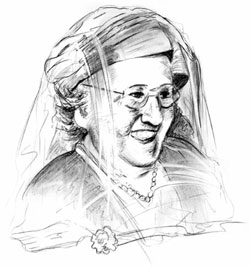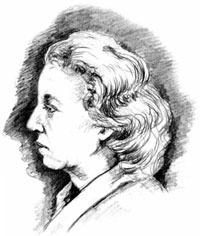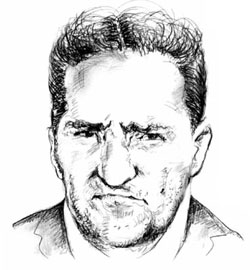Crime Time: Australians Behaving Badly (8 page)
Read Crime Time: Australians Behaving Badly Online
Authors: Sue Bursztynski
Tags: #Children's Books, #Education & Reference, #Law & Crime, #Geography & Cultures, #Explore the World, #Australia & Oceania, #Children's eBooks
CAROLINE GRILLS
C
aroline Grills was exactly the sort of person you would have wanted for a grandmother. She was a tiny thing, only about 1.22 metres in height, with a kind, smiling face. She had been happily married for many years and had children, grandchildren and many friends. When visiting, she always brought delicious food – homemade, of course.
What you
really
wouldn’t want to do was have afternoon tea with her.

In the 1940s and early 1950s, rat poison contained a nasty ingredient called thallium. If you swallowed it, you got horrible stomach pains, your hair fell out and you went blind. Finally, you would die. In most Australian states, anyone buying poison had to sign a special book, but in New South Wales anyone could buy rat poison without signing anything. Best of all, it was easy to put in food or drink and had no smell or taste. The perfect way to kill an unwanted family member!
But Caroline had other ideas. Her first victim was her stepmother, Christina Mickelson. When Caroline’s father, Mr Mickelson died, he had left his house to Christina for her lifetime, then to Caroline.
Whilst Christina lived in the lovely Sydney suburb of Ryde, Caroline and her husband lived in the not- so-nice suburb of Gladesville, where there were a lot of – yuk! – rats. Christina was 87 and Caroline thought – how long could she live anyway? Why not speed things up just a little? Poor Christina died in agony and Caroline got the house.
After this success, Caroline decided that it might be good to have a second house. Her husband Richard was going to inherit one in the Blue Mountains, from a relative, Mrs Angelina Thomas. The old lady was, after all, 84 years old. Why couldn’t she just die?
Early in 1948, Caroline’s homemade cakes and pikelets made sure she did.
Caroline had something to gain by her first two murders. But now, she started killing for fun. It made her feel good to see her victims sick and dying while she had this wonderful secret that only she knew.
Her next victim was her husband’s brother-in-law. John Lundberg was a strong, healthy man. Nobody would have expected him to become sick. But after a holiday spent with Richard and Caroline, he did – losing his hair, going blind and finally dying in October 1948. Just to be fair to her own side of the family, Caroline also finished off her brother’s widow, Mary Anne Mickelson.
After this, Caroline’s luck started to run out. John Lundberg’s widow, Eveline, became very sick, suffering cramps and going bald and blind. Of course, the kindly Caroline visited her with food and made her tea. Eveline’s daughter, Christine Downey, and her husband, John, who played cards with Caroline, also became ill. After hearing in the news of a poisoning murder, they began to wonder. Their symptoms sounded familiar. Could sweet Aunt Carrie be poisoning them?
The Downeys spoke to the police, who said they needed proof and suggested that they get some samples of Caroline’s food. John Downey managed to save some poisoned tea and they had their proof.
Caroline was arrested, to the horror of her loving husband. He couldn’t believe his wife would do anything so dreadful.
She sat smiling through her trial and joking with the police. In October 1953, she was found guilty and sentenced to life imprisonment in Long Bay jail.
Caroline lived till 1960, charming everyone in the prison. The other prisoners affectionately called her Aunt Thally. Even the staff liked her. They probably didn’t try her homemade cakes, though.

DID YOU KNOW…?
‘Pretty’ Dulcie Markham was a gangster’s moll in the 1930s. She just adored men with guns. And they adored her too, with her film-star looks. The trouble with gunmen was that they didn’t last long. Other men with guns or knives killed them. Some of her eight boyfriends killed each other over her. Dulcie must have decided she’d had enough, because finally she married a nice man who wasn’t a criminal. She might have lived happily ever after, but died in a fire in 1973 when she fell asleep smoking.
JEAN LEE
LAST WOMAN TO BE HANGED IN AUSTRALIA
W
hen Jean Lee was born in Sydney in 1919, no one would have thought she would end up on the gallows. Her family lived in North Sydney, the nicer part of the town. She did well at her studies and was good at sport. Everyone liked her.
Suddenly, at the age of only fourteen, she dropped out of school. At nineteen she married. The marriage didn’t last and by the time she was 23, she’d thrown over her old life, leaving her child with her mother and going to Brisbane.
During World War II, Jean, who liked to party, found plenty of soldiers to have fun with. She had also discovered the world of crime. In 1949, she and her boyfriend, Bobby Clayton, went back to Sydney, where they made good use of Jean’s beauty. Another friend, Norman Andrews, joined them.
What they would do was this: Jean would choose some lonely-looking man and take him into the back seat of a car. After a short time, Bobby would interrupt them, pretending to be her angry husband and threatening to bash the man up if he wasn’t given money. This worked nicely, but towards the end of the year, the three crooks decided to head for Melbourne, where they could find new victims.
While having a drink at the University Hotel in Carlton, they met an old man, Bill Kent. Bill was happy to chat with them. He was a bookie and the Melbourne Cup had just been run. He would certainly have plenty of money from bets. Their plan was to get him alone for a while so they could find out where the money was and steal it.
Jean suggested they all go back to Bill’s home, a boarding house. Bill agreed and they walked to the house in Dorritt Street. Jean was very good at persuading men to do what she wanted and Bill certainly enjoyed her company, but when she couldn’t get the money off him, things began to get nasty.
The three criminals tied Bill to a chair. They hit him with a piece of wood, smashed a beer bottle on his head and demanded to know where the money was.
Around nine o’clock, they left the room. One of them said, ‘Goodnight, Bill, I’ll see you tomorrow.’ But Mrs Hayward, who lived in the next room, was suspicious. First there had been a lot of noise, which she thought was a party. Now, suddenly, it was very quiet. Too quiet.

She called the police who arrived to find Bill, dead. Someone had strangled him with one hand. They arrested Jean, Bobby and Norman at the Great Southern Hotel in Spencer Street, in the early hours of the morning. The trio had been partying at a nightclub. They were planning to leave the state; Jean had plane tickets for Adelaide.
Bobby insisted that he had left the room early and Norman and Jean had done it all. At first, Jean refused to say anything. Then she admitted she had hit the old man and claimed that no one else was involved. She couldn’t possibly have strangled Bill, though; that would have taken someone much stronger. She was clearly protecting her boyfriend, but that didn’t help her when she was tried for murder.
The trial lasted only five days. On 25 March 1950, the court found them all guilty and sentenced them to hang. Jean appealed against the sentence, but failed. People didn’t like to see a woman hanged, but whether or not Jean had actually killed the old man, she had been involved in his torture. And she didn’t even seem to be sorry.
In the end, she probably didn’t know what was being done to her. The night before she was due to hang, 19 February 1951, Jean screamed and cried and protested that she was innocent. She was sedated and carried to the gallows in a chair.
She was the last woman in Australia to be executed.

DID YOU KNOW…?
The Melbourne branch of the Painters and Dockers Union, which had a lot of criminal members, ran a strange election in 1971. Anyone else would have simply counted the votes and elected whoever got the most. But the two men standing for the top job both wanted it very badly. To make sure he won, Billy Longley sent his men to machine-gun the ballot boxes at Williamstown, his competition’s car and the union offices in Port Melbourne. Then he found out that Pat Shannon, the other candidate, had sent his men even earlier to ‘stuff’ the ballot boxes with his own votes, while the voters waited at gunpoint. A very interesting idea of democracy!
ERIC COOKE
THE NEDLANDS MONSTER
I
f you had lived in the city of Perth in the late 1950s and early 1960s, you would have felt quite safe. It was a small town. People didn’t bother to lock their doors. Nothing could possibly happen to you in such a peaceful place, you would have thought.
You would have been wrong.
Nobody really knows why Eric Cooke started killing people. Later, he said that he just wanted to hurt someone.
Was it because of his looks or his violent childhood? He was born with a deformed face – a cleft lip – which made him ugly. Other children bullied him at school. His father bashed him when he tried to protect his mother from his dad’s violent outbursts.

Was it because he kept having accidents at work, which might have damaged his brain, perhaps? We don’t know.
Whatever his problems, he was married, with seven children. Nobody would have dreamed this good husband and father was spending his nights killing people. Certainly not his wife.
Before he became a murderer, Eric Cooke had already spent time in jail, for burglary and starting fires. He had actually burned down a church because he was annoyed at not making it into the choir. He had burned down a theatre just because he felt like it.
In 1959, a woman called Jillian Brewer was murdered in her bed. She had been stabbed and hacked about the face. She hadn’t been robbed or raped. Someone, it seemed, just liked killing. This might have been one of Cooke’s first murders.
But Eric didn’t just stab his victims. Late one night in April 1961, a couple in a parked car saw a man about to shoot them. They managed to duck just in time to avoid being killed, though they both suffered wounds.
Perhaps Eric was annoyed that he had failed to kill that time. Only an hour later, a man called George Walmsley opened his door to a knock and was shot in the head.
Police coming to George’s house made such a noise that they woke up a neighbour. She went to chat about it with her lodger, a young student called John Sturkey. Poor John was dying from a bullet in his head.
In the morning, yet another shooting was reported. Luckily that victim, an accountant, had an operation and survived.
The last murder happened in August that year. A girl called Shirley McLeod was shot while she was babysitting.
But this was the beginning of the end for Eric. He made the mistake of leaving his .22 rifle hidden by the Canning River, where an elderly couple found it only a week later. Police took it away as evidence, replacing it with another gun of the same kind. Then they waited for him to come back to collect it. Two weeks later, he did, and they arrested him. He didn’t fight. He even showed them where he had hidden another gun.
At his trial, Cooke bragged about his career as a criminal, taking credit for several hundred crimes of different kinds, including theft and knocking people over with his car. He actually admitted to two murders of which he hadn’t been accused – the murder of Jillian Brewer and of a teenager called Rosemary Anderson, whom he had knocked over in his car. The judge didn’t believe him about those, because two other men, Douglas Beamish and John Button, were serving time for them. It wasn’t until years later that evidence showed he’d been telling the truth.
Either way, it wouldn’t have made any difference to Cooke, who was executed at Fremantle Prison in October 1964. He was the last person to hang in Western Australia.

DID YOU KNOW…?
In 1970, thief Joey Turner, who had stolen thousands of dollars from security company MSS, was arrested because he’d forgotten to take some of the stolen money out of his pockets when his wife washed his clothes. Joey tried to iron out the wet $2 notes, but hadn’t the patience to wait till they were dry. He spent some money at the souvenir shop of the Southern Cross Hotel in Melbourne. When the shop assistant took the still-damp money to the bank, the clerk got suspicious and checked out the serial numbers, just in case.